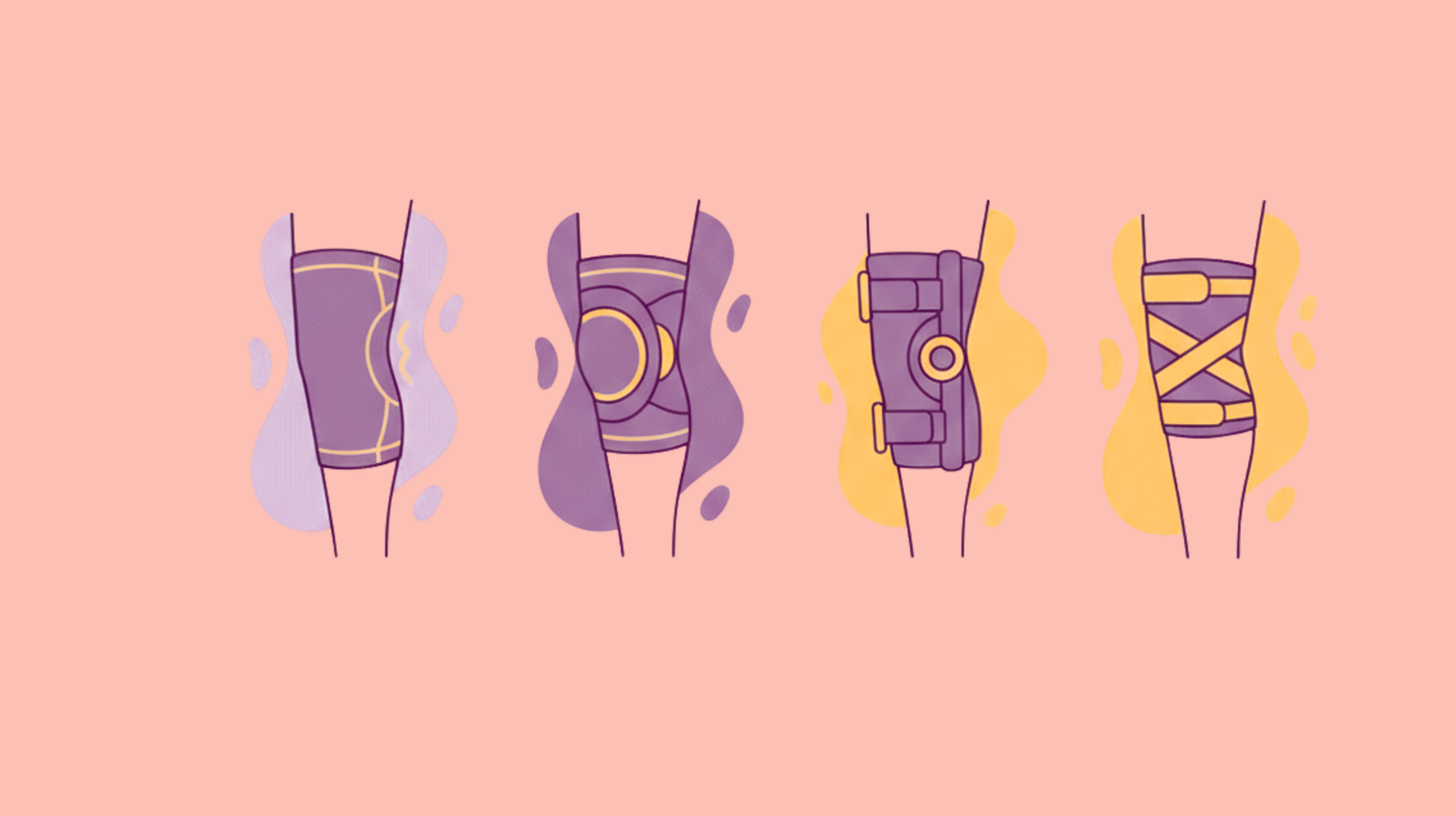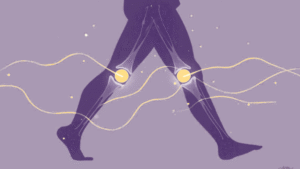Knee pain is one of the most widespread issues that affect athletes, fitness enthusiasts and even older individuals. This pain can occur because of injury, arthritis, or even wear and tear, and wearing a proper knee support can make a real change. You can recover faster with greater stability and comfort. Compression bands and hinged braces are some of the options in the market today. The top five knee supports, which are next-generation knee supports, are covered in this article. It will assist you in selecting the one that will suit you best.
Why Knee Support Is Important
Anatomy of the Knee Joint
The knee is the largest and one of the most complex joints in the body. It connects the femur (thigh bone), tibia (shin bone), and patella (kneecap) and is supported by strong ligaments, cartilage, and muscles [1]. The key ligaments ACL (anterior cruciate ligament), PCL (posterior cruciate ligament), MCL (medial collateral ligament), and LCL (lateral collateral ligament) are responsible for stabilizing movement and preventing excessive joint motion.
Cartilage structures such as the meniscus act as shock absorbers, while tendons like the quadriceps and patellar tendons connect muscles to bones, allowing for smooth extension and flexion. As the knee bears the full weight of the body during activities such as walking, running, and squatting, it is highly vulnerable to both acute injuries and long-term wear and tear.
Common Causes of Knee Pain and Instability
Arthritis:
Osteoarthritis is the most common form, affecting millions worldwide. It occurs when cartilage wears down, causing pain, stiffness, swelling, and reduced mobility. Rheumatoid arthritis, an autoimmune condition, can also inflame and damage the knee joint.
Sports Injuries (ACL, MCL, Meniscus Tears):
High-impact sports like basketball, soccer, and running frequently result in ligament sprains or tears. ACL injuries, for example, are especially common among athletes who pivot or land suddenly.
Overuse and Workout Strain:
Repetitive activities like long-distance running or improper squatting can lead to tendonitis, bursitis, or patellofemoral pain syndrome (“runner’s knee”) [2].
Aging and Wear & Tear:
With age, the cushioning cartilage in the knee gradually degenerates. Combined with reduced muscle strength, this leads to instability, stiffness, and higher risk of falls.
Benefits of Using Knee Support
Knee supports are designed to reduce the stress and strain placed on the joint while promoting proper alignment. Their main benefits include:
- Pain Relief: Compression sleeves and braces can decrease inflammation, reduce swelling, and provide immediate comfort.
- Joint Stabilization: Supports prevent excessive lateral or rotational movement, reducing the risk of ligament damage.
- Improved Mobility and Confidence: Many users report being able to walk or run with greater ease when wearing knee supports.
- Faster Recovery: By improving blood flow and reducing stress, supports help accelerate healing after injury or surgery [3].
- Preventive Care: Athletes use supports to protect against overuse injuries, while older adults rely on them for daily stability.
Using the right type of support often makes the difference between staying active and being limited by pain.
Types of Knee Support Available
Knee supports are not one-size-fits-all. The right choice depends on your condition, activity level, and specific goals. Here are the most common types:
1. Knee Sleeves (Compression-Based)
Knee sleeves are slip-on garments usually made of elastic fabric or neoprene. They provide mild to moderate compression, which improves circulation, reduces swelling, and helps with general knee discomfort. Unlike bulky braces, sleeves are lightweight and flexible, making them perfect for running, gym workouts, or everyday use.
Best for: mild arthritis pain, workout strain, or runners seeking light support.
2. Hinged Knee Braces (Maximum Support)
Hinged braces feature metal or plastic supports on the sides of the knee to control movement. They are designed for individuals recovering from serious ligament injuries (e.g., ACL or MCL tears). Hinges prevent hyperextension and provide strong lateral stability, making them the most protective type of knee support [4].
Best for: post-injury recovery, post-surgery, or athletes returning to high-impact sports.
3. Open-Patella Knee Braces (Targeted Pressure Relief)
These braces have a circular cut-out around the kneecap (patella). The opening reduces pressure on the kneecap, improves tracking, and relieves stress for those with patellofemoral pain or tendonitis.
Best for: patellar instability, runner’s knee, or conditions where pressure on the kneecap worsens symptoms.
4. Knee Straps and Wraps (Localized Tendon Support)
Straps are simple, adjustable bands worn below the kneecap. They apply targeted pressure on the patellar tendon, relieving pain from conditions like jumper’s knee (patellar tendonitis) [5]. Wraps, on the other hand, provide customizable compression around the joint.
Best for: athletes with tendonitis or those needing lightweight, non-restrictive support.
5. Specialized Supports for Sports and Arthritis
Some supports are designed with arthritis patients in mind, using softer, cushioned materials for comfort. Others are built for athletes, combining lightweight fabrics with reinforced stability for dynamic sports.
Best for: users with specific needs (e.g., arthritis sufferers, long-distance runners, or weightlifters).
Best Knee Supports in 2025
When it comes to choosing a knee support, the options can feel overwhelming. Every brand promises comfort, stability, and long-term durability, but in reality, the effectiveness depends on design, materials, and whether it meets the specific needs of the user. After reviewing top-rated products, medical recommendations, and customer feedback, here are the five best knee supports in 2025, including the much-discussed Betterhood Knee Support Brace.
1. Betterhood Knee Support Brace (Featured Product)
Among the most popular and affordable options in 2025, the Betterhood Knee Support Brace has gained attention for its combination of breathable fabric, strong compression, and ergonomic design.
- Features:
- Adjustable Velcro straps for a customizable fit.
- Breathable, sweat-resistant fabric suitable for long workouts.
- Dual-spring stabilizers for lateral support without restricting movement.
- Anti-slip silicone strips to prevent sliding during exercise.

- Benefits:
The Betterhood brace offers effective pain relief, particularly for arthritis and tendonitis. Its compression helps reduce swelling, while the stabilizers add support for weak or recovering knees. It provides a strong sense of security during dynamic activities such as running, squats, or HIIT training.
- Best For:
- Fitness enthusiasts needing joint stabilization during workouts.
- Older adults seeking affordable relief from arthritis pain.
- Runners recovering from mild injuries who still want mobility.
- Why It Stands Out:
While many premium braces can be expensive, Betterhood has carved out a niche by offering durable, affordable, and multipurpose support. Users appreciate that it doesn’t feel bulky and can be worn for hours without discomfort. For its price, it delivers exceptional value.
Bauerfeind GenuTrain Knee Brace
If Betterhood represents affordability, Bauerfeind GenuTrain represents premium German engineering. This brace is well-regarded by physiotherapists and orthopedic specialists worldwide.
- Features:
- 3D knitted fabric for a snug, anatomical fit.
- Integrated viscoelastic pads that massage muscles during movement.
- Breathable and lightweight material for long wear.
- Slip-resistant design with reinforced zones around the patella.
- Benefits:
GenuTrain is particularly beneficial for people with arthritis, meniscus injuries, or post-surgical recovery. The unique viscoelastic pads improve circulation and reduce muscle tension while stabilizing the knee. Unlike bulky braces, it feels almost seamless under clothing.
- Best For:
- Arthritis sufferers seeking long-term comfort.
- Post-surgery patients require gentle, effective stabilization.
- Users who don’t mind paying extra for premium quality.
- Why It Stands Out:
Bauerfeind has a reputation for medical-grade quality. While it costs more than most alternatives, it is a worthwhile investment for those who need a brace they can trust for daily or clinical use.
3. McDavid Hinged Knee Brace
For athletes recovering from serious ligament injuries, the McDavid Hinged Knee Brace is often the go-to choice. It’s a heavy-duty support that prioritizes stability above all else.
- Features:
- Bilateral polycentric hinges for full-range protection.
- Padded, moisture-wicking neoprene sleeve for comfort.
- Hook-and-loop straps for a secure, adjustable fit.
- Reinforced side stabilizers to prevent lateral movement.
- Benefits:
This brace offers maximum protection against instability caused by ACL or MCL injuries. The hinges prevent hyperextension and provide structured support, making it one of the most secure braces available. While bulkier than sleeves, it gives athletes confidence when returning to play after major injuries.
- Best For:
- Athletes recovering from ligament tears or instability.
- Contact sports players (football, basketball) who need heavy-duty support.
- Users with recurring joint buckling or instability.
- Why It Stands Out:
McDavid combines strength and adjustability, making it highly effective for post-injury rehabilitation. It is not designed for everyday casual use but excels when serious stabilization is needed.
4. Shock Doctor Knee Compression Sleeves
For users who prefer a lightweight and affordable solution, the Shock Doctor Compression Sleeve is a reliable option. It balances affordability with performance, making it popular among athletes and casual exercisers alike.
- Features:
- Breathable, moisture-wicking neoprene fabric.
- Four-way stretch for flexibility and comfort.
- Targeted compression zones to reduce swelling.
- Sleek design that fits easily under sports gear.
- Benefits:
The Shock Doctor sleeve provides moderate compression that helps with swelling, circulation, and general knee discomfort. It doesn’t restrict movement, making it ideal for sports activities like basketball, running, and weightlifting.
- Best For:
- Athletes who need a lightweight sleeve for regular training.
- People with mild knee pain, tendonitis, or swelling.
- Budget-conscious buyers looking for a balance of performance and affordability.
Why It Stands Out:
- This sleeve is proof that you don’t have to spend a fortune for effective support. While it doesn’t offer the heavy-duty stability of hinged braces, it provides consistent, comfortable support for everyday sports and activities.
5. Copper Fit Pro Knee Sleeve
The Copper Fit Pro Knee Sleeve has carved out a loyal following, largely due to its combination of lightweight comfort and copper-infused fabric.
- Features:
- Infused with copper ions for odor resistance.
- Soft, breathable, and flexible design.
- Easy slip-on style for quick wear.
- Provides mild compression.
- Benefits:
The Copper Fit sleeve is particularly useful for daily wear, offering enough compression to manage mild pain and stiffness without feeling restrictive. Its copper infusion also helps with odor control, making it a practical choice for users who wear supports for long hours.
- Best For:
- Mild arthritis or age-related knee discomfort.
- Users seeking a lightweight, all-day solution.
- Casual exercisers who don’t need intense stabilization.
- Why It Stands Out:
Unlike braces designed for medical recovery or sports injuries, Copper Fit is best for comfort and convenience. It may not suit those with severe injuries, but for daily knee pain management, it is one of the most practical and budget-friendly options.
Comparative Overview
- Best All-Rounder: Betterhood Knee Support Brace balances affordability, stability, and comfort.
- Best Premium Choice: Bauerfeind GenuTrain Knee Brace clinical-grade support for arthritis and recovery.
- Best for Serious Injuries: McDavid Hinged Knee Brace heavy-duty stabilization for ligament injuries.
- Best Budget Sports Sleeve: Shock Doctor Compression Sleeve reliable and affordable support for athletes.
- Best for Daily Wear: Copper Fit Pro Knee Sleeve lightweight, odor-resistant, and easy to wear.
Together, these five supports represent the full spectrum of user needs from affordable compression to advanced stabilization. The key is not just choosing the most expensive option but matching the brace or sleeve to your individual condition and activity level.
How to Choose the Right Knee Support?
Selecting the right knee support is not about picking the most expensive brace or the most popular sleeve. Instead, it depends on your condition, lifestyle, and activity level. Below are the main factors to consider:
Based on Your Condition
- Mild Pain or Swelling: A compression sleeve (like Shock Doctor or Copper Fit) provides enough support and promotes circulation.
- Chronic Arthritis or Patellar Issues: A premium sleeve with anatomical support (like Bauerfeind GenuTrain) helps long-term.
- Injury Recovery (MCL, ACL, Meniscus): A hinged brace (like McDavid) provides heavy-duty stabilization.
- General Gym or Sports Use: A mid-level brace (like Betterhood) balances flexibility and compression.
Fit and Comfort
- Measure your thigh and calf circumference to avoid choosing a brace that’s too tight or too loose.
- Breathable, sweat-resistant fabric is critical if you wear it for long hours.
- Anti-slip silicone strips prevent constant readjustment.
Purpose of Use
- Sports: Lightweight, flexible braces for freedom of movement.
- Daily Wear: Slim, breathable designs that fit under clothing.
- Rehabilitation: Hinged braces or reinforced stabilizers for maximum support.
Benefits of Using Knee Support
Knee supports are not just accessories, they are tools that can improve function, protect joints, and enhance recovery.
1. Pain Relief
Compression helps reduce swelling and inflammation, offering immediate relief for arthritis or tendonitis.
2. Injury Prevention
Athletes using knee braces during high-impact activities experience fewer ligament sprains, especially in sports like basketball or football [5].
3. Enhanced Stability
Supports provide confidence for people whose knees buckle or give way due to weakness or old injuries.
4. Faster Recovery
By limiting harmful movements while allowing safe mobility, braces help tissues heal quicker post-surgery or post-injury.
5. Psychological Confidence
Many athletes admit they feel “safer” when wearing a brace, which allows them to return to activity with less fear of re-injury [6].
Precautions While Using Knee Support
While knee supports are beneficial, misuse can cause problems.
1. Don’t Over-Rely on Braces
Long-term overuse without strengthening exercises can weaken supporting muscles.
2. Get Medical Advice
For chronic or severe pain, consult an orthopedist before choosing a brace.
3. Choose the Right Size
Too tight—restricts blood flow; too loose ineffective.
4. Don’t Use as a Substitute for Rehab
Supports and complements physiotherapy but cannot replace it.
5. Check Skin Health
Extended use may cause skin irritation; opt for breathable materials.
Supporting Exercises for Stronger Knees
Braces help, but long-term knee health requires strong muscles. Here are safe, brace-friendly exercises:
Quadriceps Strengthening
- Straight Leg Raises: Lying flat, lift one leg at a time while keeping the knee straight.
- Wall Sits: Hold a squat against the wall for 30-60 seconds.
Hamstring & Glute Activation
- Bridges: Lie on your back, bend knees, and lift hips upward.
- Hamstring Curls: Use resistance bands or gym machines.
Low-Impact Cardio
- Cycling and swimming reduce stress on joints while strengthening them.
Balance Training
- Standing on one leg or using a balance board improves stability.
Stretching
- Regular calf, hamstring, and quad stretches keep muscles flexible, reducing joint strain.
Conclusion
The right knee support has the ability to reduce immense pain and prevent your knees from further injuries. It is a product that would suit any condition and lifestyle, with the higher-priced products such as the Bauerfeind GenuTrain, and the more affordable products such as the Betterhood Knee Support Brace. It is important to remember that braces could be used in the most effective ways only with the help of strength training and with the correct medical prescriptions. In the long run, wise decisions will result in an increased level of mobility, a quicker recovery, and improved health of the joint.
Frequently Asked Questions:
1. Can I wear knee support all day?
Yes, lightweight sleeves can be worn daily, but heavy-duty braces should be used only during activity or recovery periods.
2. Are knee supports effective for arthritis?
Yes, compression sleeves and premium supports like Bauerfeind GenuTrain help relieve pain and provide stability.
3. Do athletes really benefit from knee braces?
Yes, especially in high-impact sports. Braces reduce the risk of sprains and provide confidence after injuries.
4. Which is better: a knee sleeve or a hinged brace?
- Sleeve: Lightweight, best for mild pain or prevention.
- Hinged Brace: Heavier, best for post-injury or instability.
5. Can knee supports weaken muscles?
Not if used correctly. They should be combined with strengthening exercises to avoid dependency.
References
- Prathap Kumar, J., Arun Kumar, M., & Venkatesh, D. (2020). Healthy gait: Review of anatomy and physiology of knee joint. International Journal of Current Research and Review, 12(6), 1-8. DOI: http://dx.doi.org/10.31782/IJCRR.2020.12061
- Olson, A. Common Injuries and Therapy Management for Runners. CE for New York Physical Therapy Professionals, 35. https://s3.amazonaws.com/EliteCME_WebSite_2013/f/pdf/PTNY04TRI17.pdf
- Najibi, S., & Albright, J. P. (2005). The use of knee braces, part 1: prophylactic knee braces in contact sports. The American journal of sports medicine, 33(4), 602-611. https://doi.org/10.1177/0363546505275128
- Rodríguez-Merchán, E. C. (2019). Total knee arthroplasty using hinge joints: indications and results. EFORT open reviews, 4(4), 121-132. DOI: https://doi.org/10.1302/2058-5241.4.180056
- de Vries, A. J., van den Akker-Scheek, I., Diercks, R. L., Zwerver, J., & van der Worp, H. (2016). The effect of a patellar strap on knee joint proprioception in healthy participants and athletes with patellar tendinopathy. Journal of science and medicine in sport, 19(4), 278-282. https://doi.org/10.1016/j.jsams.2015.04.016
- Kvist, J., Bengtsson, J., & Lundqvist, C. (2023). The experience and influence of fear after anterior cruciate ligament reconstruction: an interview study with young athletes. BMC Sports Science, Medicine and Rehabilitation, 15(1), 50. https://doi.org/10.1186/s13102-023-00659-7



















